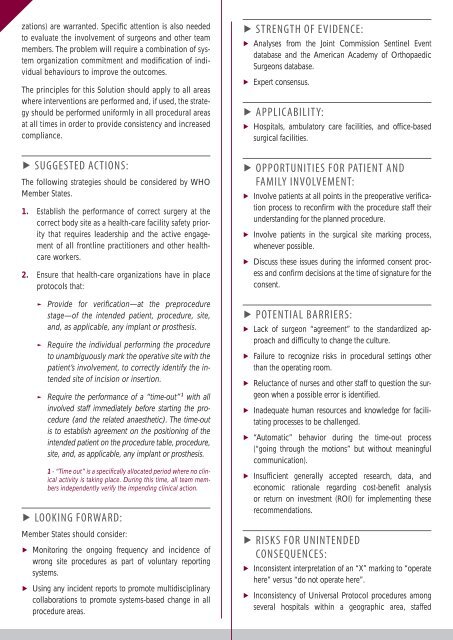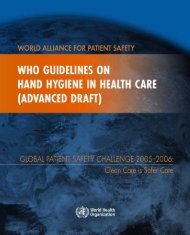Performance of Correct Procedure at Correct Body Site pdf, 752kb
Performance of Correct Procedure at Correct Body Site pdf, 752kb
Performance of Correct Procedure at Correct Body Site pdf, 752kb
Create successful ePaper yourself
Turn your PDF publications into a flip-book with our unique Google optimized e-Paper software.
z<strong>at</strong>ions) are warranted. Specific <strong>at</strong>tention is also needed<br />
to evalu<strong>at</strong>e the involvement <strong>of</strong> surgeons and other team<br />
members. The problem will require a combin<strong>at</strong>ion <strong>of</strong> system<br />
organiz<strong>at</strong>ion commitment and modific<strong>at</strong>ion <strong>of</strong> individual<br />
behaviours to improve the outcomes.<br />
The principles for this Solution should apply to all areas<br />
where interventions are performed and, if used, the str<strong>at</strong>egy<br />
should be performed uniformly in all procedural areas<br />
<strong>at</strong> all times in order to provide consistency and increased<br />
compliance.<br />
▶<br />
▶<br />
▶<br />
▶<br />
▶<br />
STRENGTH OF EVIDENCE:<br />
Analyses from the Joint Commission Sentinel Event<br />
d<strong>at</strong>abase and the American Academy <strong>of</strong> Orthopaedic<br />
Surgeons d<strong>at</strong>abase.<br />
Expert consensus.<br />
APPLICABILITY:<br />
Hospitals, ambul<strong>at</strong>ory care facilities, and <strong>of</strong>fice-based<br />
surgical facilities.<br />
▶<br />
SUGGESTED ACTIONS:<br />
The following str<strong>at</strong>egies should be considered by WHO<br />
Member St<strong>at</strong>es.<br />
1.<br />
2.<br />
▶<br />
Establish the performance <strong>of</strong> correct surgery <strong>at</strong> the<br />
correct body site as a health-care facility safety priority<br />
th<strong>at</strong> requires leadership and the active engagement<br />
<strong>of</strong> all frontline practitioners and other healthcare<br />
workers.<br />
Ensure th<strong>at</strong> health-care organiz<strong>at</strong>ions have in place<br />
protocols th<strong>at</strong>:<br />
►<br />
►<br />
►<br />
Provide for verific<strong>at</strong>ion—<strong>at</strong> the preprocedure<br />
stage—<strong>of</strong> the intended p<strong>at</strong>ient, procedure, site,<br />
and, as applicable, any implant or prosthesis.<br />
Require the individual performing the procedure<br />
to unambiguously mark the oper<strong>at</strong>ive site with the<br />
p<strong>at</strong>ient’s involvement, to correctly identify the intended<br />
site <strong>of</strong> incision or insertion.<br />
Require the performance <strong>of</strong> a “time-out” 1 with all<br />
involved staff immedi<strong>at</strong>ely before starting the procedure<br />
(and the rel<strong>at</strong>ed anaesthetic). The time-out<br />
is to establish agreement on the positioning <strong>of</strong> the<br />
intended p<strong>at</strong>ient on the procedure table, procedure,<br />
site, and, as applicable, any implant or prosthesis.<br />
1 - “Time out” is a specifically alloc<strong>at</strong>ed period where no clinical<br />
activity is taking place. During this time, all team members<br />
independently verify the impending clinical action.<br />
LOOKING FORWARD:<br />
Member St<strong>at</strong>es should consider:<br />
▶<br />
▶<br />
Monitoring the ongoing frequency and incidence <strong>of</strong><br />
wrong site procedures as part <strong>of</strong> voluntary reporting<br />
systems.<br />
Using any incident reports to promote multidisciplinary<br />
collabor<strong>at</strong>ions to promote systems-based change in all<br />
procedure areas.<br />
▶<br />
▶<br />
▶<br />
▶<br />
▶<br />
▶<br />
▶<br />
▶<br />
▶<br />
▶<br />
▶<br />
▶<br />
▶<br />
▶<br />
OPPORTUNITIES FOR PATIENT AND<br />
FAMILY INVOLVEMENT:<br />
Involve p<strong>at</strong>ients <strong>at</strong> all points in the preoper<strong>at</strong>ive verific<strong>at</strong>ion<br />
process to reconfirm with the procedure staff their<br />
understanding for the planned procedure.<br />
Involve p<strong>at</strong>ients in the surgical site marking process,<br />
whenever possible.<br />
Discuss these issues during the informed consent process<br />
and confirm decisions <strong>at</strong> the time <strong>of</strong> sign<strong>at</strong>ure for the<br />
consent.<br />
POTENTIAL BARRIERS:<br />
Lack <strong>of</strong> surgeon “agreement” to the standardized approach<br />
and difficulty to change the culture.<br />
Failure to recognize risks in procedural settings other<br />
than the oper<strong>at</strong>ing room.<br />
Reluctance <strong>of</strong> nurses and other staff to question the surgeon<br />
when a possible error is identified.<br />
Inadequ<strong>at</strong>e human resources and knowledge for facilit<strong>at</strong>ing<br />
processes to be challenged.<br />
“Autom<strong>at</strong>ic” behavior during the time-out process<br />
(“going through the motions” but without meaningful<br />
communic<strong>at</strong>ion).<br />
Insufficient generally accepted research, d<strong>at</strong>a, and<br />
economic r<strong>at</strong>ionale regarding cost-benefit analysis<br />
or return on investment (ROI) for implementing these<br />
recommend<strong>at</strong>ions.<br />
RISKS FOR UNINTENDED<br />
CONSEQUENCES:<br />
Inconsistent interpret<strong>at</strong>ion <strong>of</strong> an “X” marking to “oper<strong>at</strong>e<br />
here” versus “do not oper<strong>at</strong>e here”.<br />
Inconsistency <strong>of</strong> Universal Protocol procedures among<br />
several hospitals within a geographic area, staffed
















